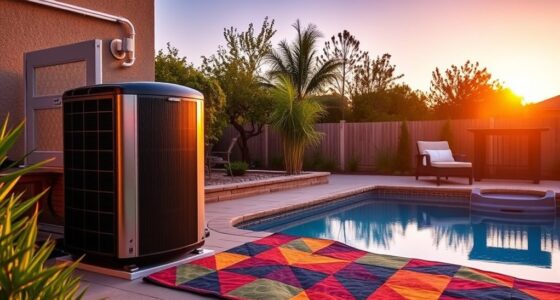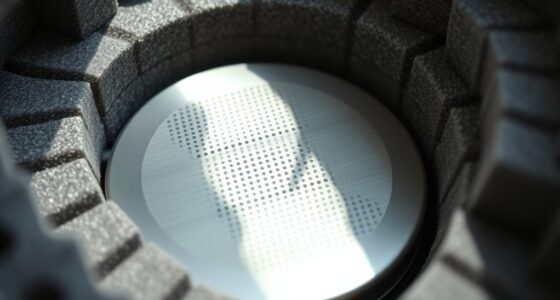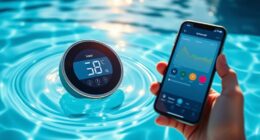To cut your pool operation costs, start with a thorough energy audit to identify inefficiencies. Check your equipment, water chemistry, and insulation, and make certain you’re using energy-efficient pumps, heaters, and lighting. Maintaining proper chemical balance and using a cover consistently can also reduce energy loss. Regularly monitor performance and schedule routine maintenance. Keep these tips in mind as you explore ways to optimize your system and save money over time.
Key Takeaways
- Conduct a thorough energy audit to identify inefficiencies in heating, filtration, and circulation systems.
- Optimize pool cover use and insulation to reduce heat loss and evaporation, lowering energy demands.
- Upgrade to energy-efficient pumps, filters, and lighting to minimize operational energy consumption.
- Regularly maintain equipment and monitor water chemistry to prevent unnecessary energy use.
- Explore renewable energy options like solar heating and panels to offset and reduce overall energy costs.
Understanding the Components of Your Pool’s Energy Use
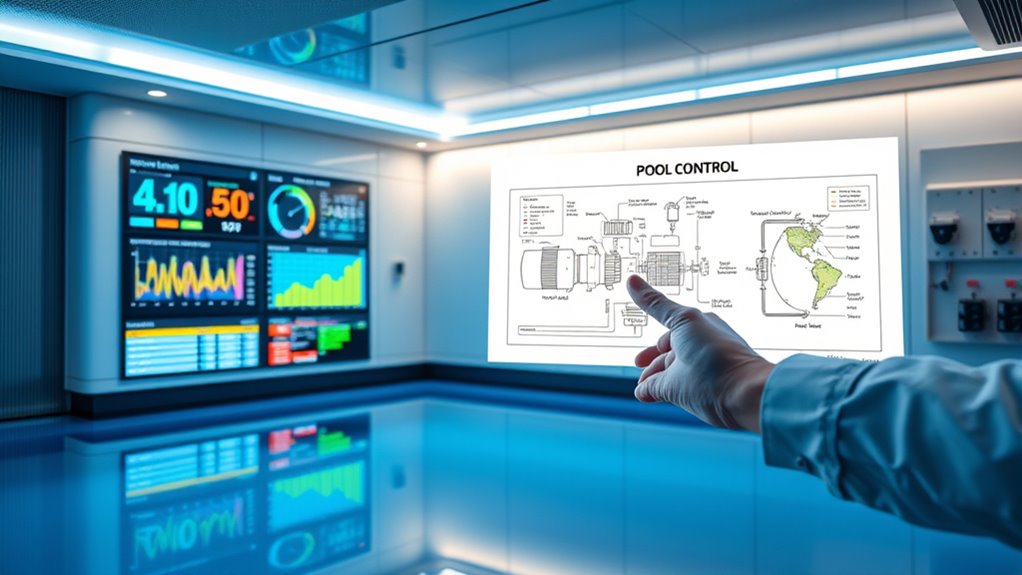
To effectively reduce your pool’s energy consumption, you first need to understand its main components. The pool cover plays an essential role by minimizing heat loss through evaporation, helping you retain warmth without overworking your heater. Proper chemical management also impacts energy use; maintaining balanced chemicals prevents algae growth and reduces the need for excessive filtration and chemical treatments. A well-chosen pool cover can decrease the amount of energy needed to heat and circulate water, while good chemical management ensures your filtration system runs efficiently. Additionally, selecting energy-efficient equipment can further reduce operational costs. Upgrading to high-efficiency pumps and automated controls can significantly cut energy use over time. Implementing a regular maintenance schedule can optimize equipment performance and prevent unnecessary energy waste. Regularly monitoring your pool’s energy consumption helps identify areas for improvement and ensures your system operates at peak efficiency. By focusing on these key components, you can cut down on unnecessary energy use, save money, and keep your pool operating smoothly. Understanding how these elements interact allows you to make smarter, energy-efficient choices.
Signs That Your Pool Might Benefit From an Energy Audit
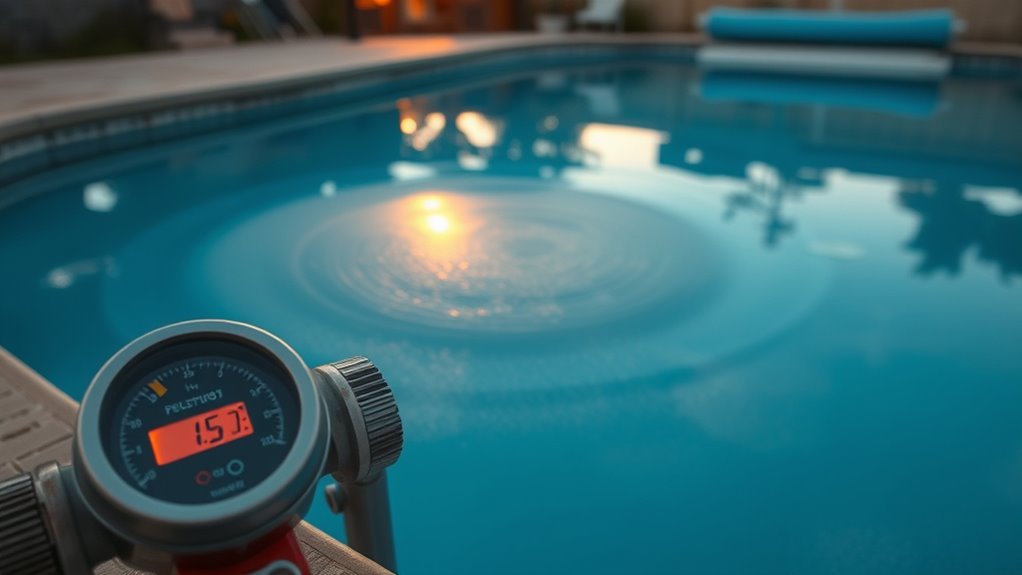
If your energy bills are unusually high, it might be a sign that your pool is wasting energy. You could also notice inconsistent water temperatures, making it hard to enjoy your pool comfortably. These issues suggest it’s time to contemplate an energy audit to identify and fix inefficiencies. Additionally, energy monitoring features can be helpful if you need to visit a store for equipment or consultation. Implementing energy-efficient equipment such as variable-speed pumps can significantly reduce operational costs and improve overall efficiency. Upgrading to pool system components designed for better energy performance can further optimize your pool’s operation. Regularly inspecting your bicycle tires for wear and tear can also prevent unnecessary energy consumption in related equipment, ensuring better overall system performance.
Unusually High Energy Bills
When your energy bills suddenly spike without a clear reason, it’s a strong sign that your pool may be wasting power. High bills can stem from inefficient equipment, but issues like poor chemical balance can also cause your pool to work harder than necessary. For example, if your chemical levels aren’t properly maintained, your system may run longer or strain to keep water clean. Additionally, relying heavily on solar heating that’s not properly optimized or failing to adjust for seasonal changes can lead to increased energy use. Proper wall organization systems can also improve pool equipment setup, making maintenance more efficient and reducing energy consumption. Using energy-efficient pumps can significantly cut down on power usage as well. Regularly inspecting your pool equipment for malfunctions or wear can prevent unnecessary energy drain. Maintaining proper chemical balance is essential because unbalanced water can cause equipment to work harder, wasting energy and increasing costs. These signs indicate your pool isn’t operating efficiently. An energy audit can identify underlying problems, so you can tweak your system—like improving chemical balance or optimizing solar heating—to reduce energy consumption and lower bills. Regular maintenance and monitoring of system components can further prevent inefficiencies before they escalate.
Inconsistent Pool Temperatures
Noticing that your pool temperature fluctuates unexpectedly is a clear sign that your system may be inefficient. When your pool isn’t maintaining a consistent temperature, it often indicates issues like poor insulation or equipment problems. Additionally, inconsistent chlorine levels can affect water chemistry, prompting you to adjust the heater unnecessarily. If you don’t use a pool cover regularly, heat escapes more quickly, causing temperature swings and increasing energy costs. Proper pool cover usage helps retain heat, stabilizing temperatures and reducing energy consumption. Addressing these issues through an energy audit can identify insulation gaps, equipment inefficiencies, and ideal cover practices. By maintaining consistent temperatures, you save on heating costs and improve overall pool performance.
How to Prepare for an Effective Pool Energy Assessment
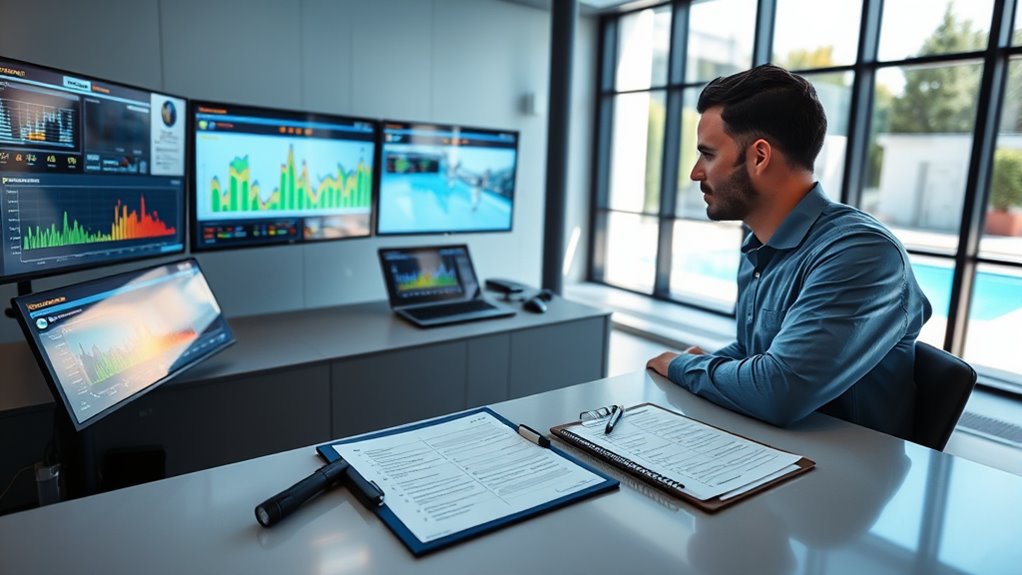
Preparing for a pool energy assessment starts with gathering essential information and making necessary arrangements. First, review your water chemistry records to guarantee proper chemical balance, as imbalances can affect equipment efficiency. Next, confirm that safety protocols are in place, including clear signage, accessible emergency equipment, and trained staff on-site. Prepare detailed documentation of your current energy usage, including utility bills and equipment specifications. Ensure the pool area is clean and accessible for the assessor to inspect all equipment thoroughly. Additionally, compile maintenance logs and previous repair records. Monitoring automation technologies can help identify areas where energy consumption can be optimized. Being familiar with energy management practices can further facilitate identifying savings opportunities. Understanding energy efficiency strategies can also enhance the assessment process and result in more effective recommendations. Incorporating regular maintenance routines ensures equipment operates at peak efficiency, which can be a critical aspect of the assessment. By organizing this information and guaranteeing safety procedures are followed, you’ll help the assessor identify energy-saving opportunities more effectively, leading to a more thorough and productive assessment.
Key Areas to Focus on During the Audit
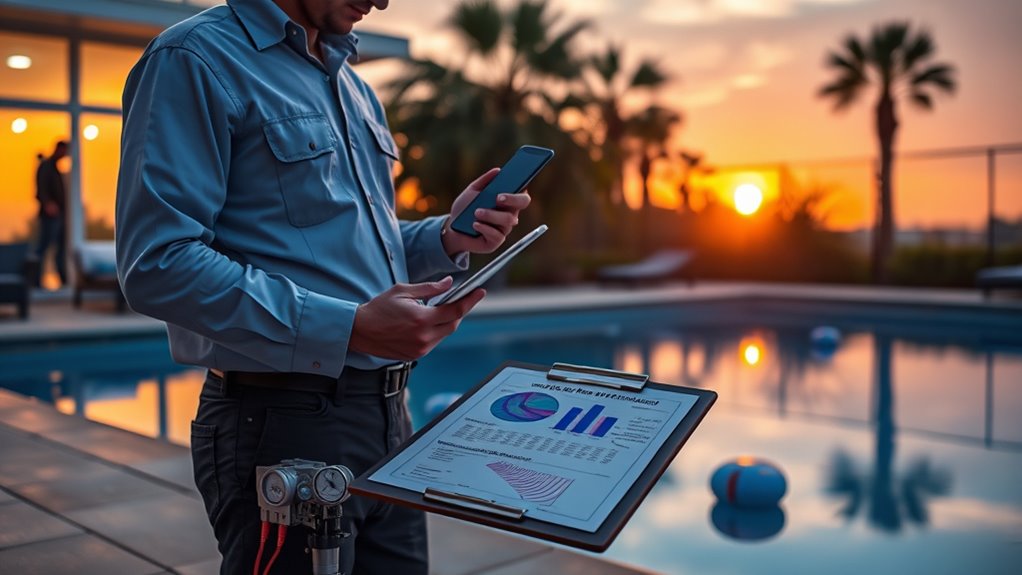
When conducting your energy audit, start by checking pump efficiency to identify any unnecessary energy use. Then, evaluate your lighting system to spot opportunities for upgrades or adjustments. Focusing on these areas can lead to significant energy savings and improved system performance. Additionally, assessing your irrigation system’s water management practices can help reduce costs and conserve resources.
Pump Efficiency Checks
To guarantee peak pump performance during an energy audit, focus on key areas that directly impact efficiency. Check for proper flow rates and ensure the pump isn’t overworking, which wastes energy. Inspect the pump’s impeller and motor for signs of wear or debris that could reduce efficiency. Evaluate if the pool’s solar heating system is integrated effectively, reducing reliance on the pump’s workload. Proper chemical management also plays a role; balanced water minimizes strain on filtration and circulation systems. Confirm that valves are correctly positioned and that there are no leaks, as leaks increase energy costs. Regular maintenance, including cleaning filters and replacing worn parts, keeps the pump operating at peak efficiency, saving you money and extending equipment lifespan.
Lighting System Evaluation
Have you thoroughly assessed your lighting system’s efficiency during the audit? Proper lighting evaluation can markedly reduce energy costs. Focus on lighting maintenance to make certain fixtures are clean and functioning correctly. Check if bulbs are nearing the end of their lifespan, which can cause dimming and increased energy use. Examine the placement of lights to avoid over-illumination and waste. Consider upgrading to energy-efficient options like LEDs if current bulbs are outdated. Look for flickering or inconsistent lighting that might indicate wiring issues. Also, review control systems, such as timers or sensors, to optimize usage. Visualize a pool area where lights are evenly distributed, bright without glare, and only on when needed. Addressing these areas helps maximize efficiency and extend bulb lifespan, lowering operational costs.
Implementing Energy-Saving Measures Post-Audit
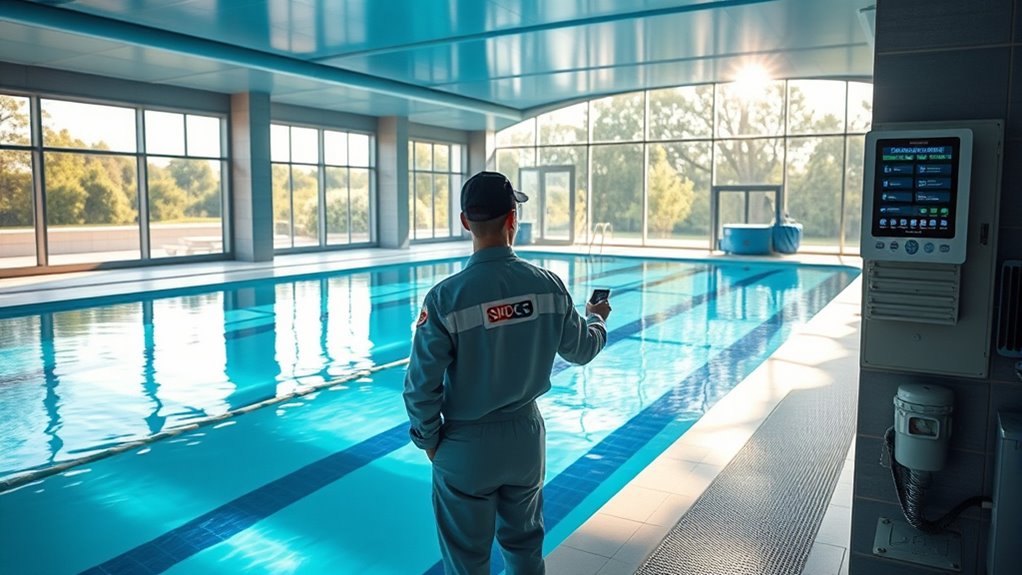
After completing an energy audit, the next essential step is to implement the recommended energy-saving measures. Start by evaluating options like solar heating systems, which can considerably reduce your energy costs by harnessing free, renewable energy. Installing solar panels for pool heating is an effective way to cut expenses and decrease your carbon footprint. Additionally, consider filtration upgrades—upgrading to energy-efficient pumps and filters can lower electricity consumption while maintaining water quality. Prioritize these upgrades based on your audit findings, and create a clear plan for installation. Keep in mind that proper implementation is crucial; ensure that new systems are correctly installed and integrated into your existing setup. Taking these steps will help you maximize savings and set the stage for ongoing efficiency improvements.
Monitoring and Maintaining Energy Efficiency Over Time

Implementing energy-saving measures is only the beginning; maintaining their effectiveness requires ongoing monitoring. Regular checks help guarantee your pool stays efficient and costs stay low. Keep an eye on:
Regular monitoring ensures your pool remains efficient and cost-effective over time.
- Properly using pool cover options to reduce heat loss and evaporation
- Maintaining a stable chemical balance to prevent energy waste caused by imbalanced water chemistry
- Monitoring pump and filter operation for peak performance
- Adjusting settings based on seasonal changes and usage patterns
Frequently Asked Questions
What Are the Typical Costs Involved in a Professional Pool Energy Audit?
When considering an energy audit for your pool, you’ll want to know about the typical costs involved. Energy audit costs usually include professional assessment fees, which vary based on pool size and complexity. Expect to pay anywhere from a few hundred to over a thousand dollars. These fees cover the expert’s time and equipment needed to identify energy-saving opportunities, helping you save money on your pool’s operation costs long-term.
How Long Does a Comprehensive Pool Energy Audit Usually Take?
A thorough pool energy audit usually takes between 2 to 4 hours. During this time, you’ll review pool equipment efficiency and assess current maintenance schedules. You’ll examine pumps, filters, and heaters to identify energy-saving opportunities. By understanding how your equipment operates and how maintenance is scheduled, you can make informed decisions to improve efficiency and reduce costs, ensuring your pool runs smoothly and economically.
Can Energy-Saving Upgrades Be Financed or Subsidized?
Imagine your pool shining brighter and costing less to run. You can tap into government incentives and financing options that make energy-saving upgrades more affordable. These programs often provide subsidies or low-interest loans, easing your investment. By exploring these options, you turn your pool into an eco-friendly oasis, saving money while helping the environment. Don’t miss out on these financial perks—start researching government incentives and financing options today.
What Are Common Mistakes to Avoid After Implementing Energy Measures?
After implementing energy measures, you should watch out for maintenance pitfalls that can reduce efficiency. Avoid neglecting regular upkeep, like cleaning filters and inspecting equipment, which can lead to higher energy use. Also, don’t overlook opportunities to optimize operation schedules or upgrade controls. Staying proactive with maintenance and continuously reviewing your systems helps you maximize savings and prevent costly issues, ensuring your energy investments deliver lasting benefits.
How Often Should I Conduct Follow-Up Energy Assessments?
Think of your pool’s energy efficiency like tending a garden—you need regular care. You should conduct follow-up energy assessments every 6 to 12 months, depending on your maintenance schedule. During these checks, focus on energy consumption tracking to spot inefficiencies early. This routine helps you stay on top of operational costs, ensuring your pool runs smoothly and efficiently, just like a well-tended garden flourishes.
Conclusion
Just like Icarus learned, soaring too close to the sun without safeguards can lead to a fall. By understanding your pool’s energy use, conducting thorough audits, and implementing smart improvements, you can keep your costs down and your pool shining. Regular monitoring guarantees you stay on course, avoiding costly pitfalls. With proactive steps, you’ll enjoy a more efficient, budget-friendly pool experience—because, like a well-tuned orchestra, harmony is achieved through attentive care.


